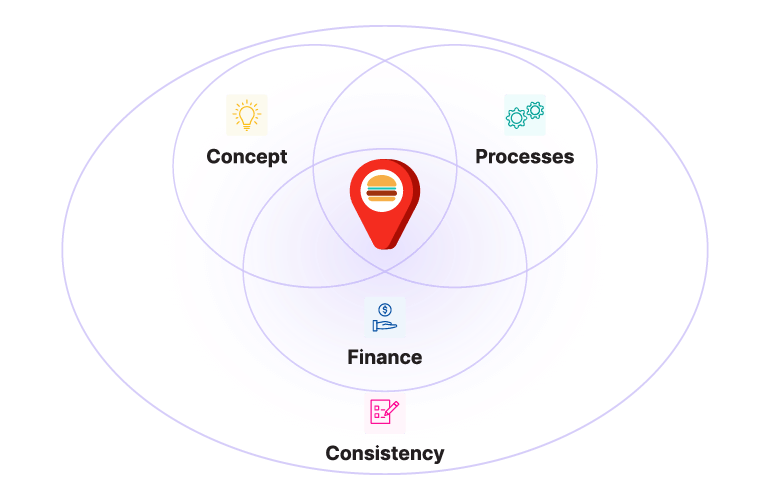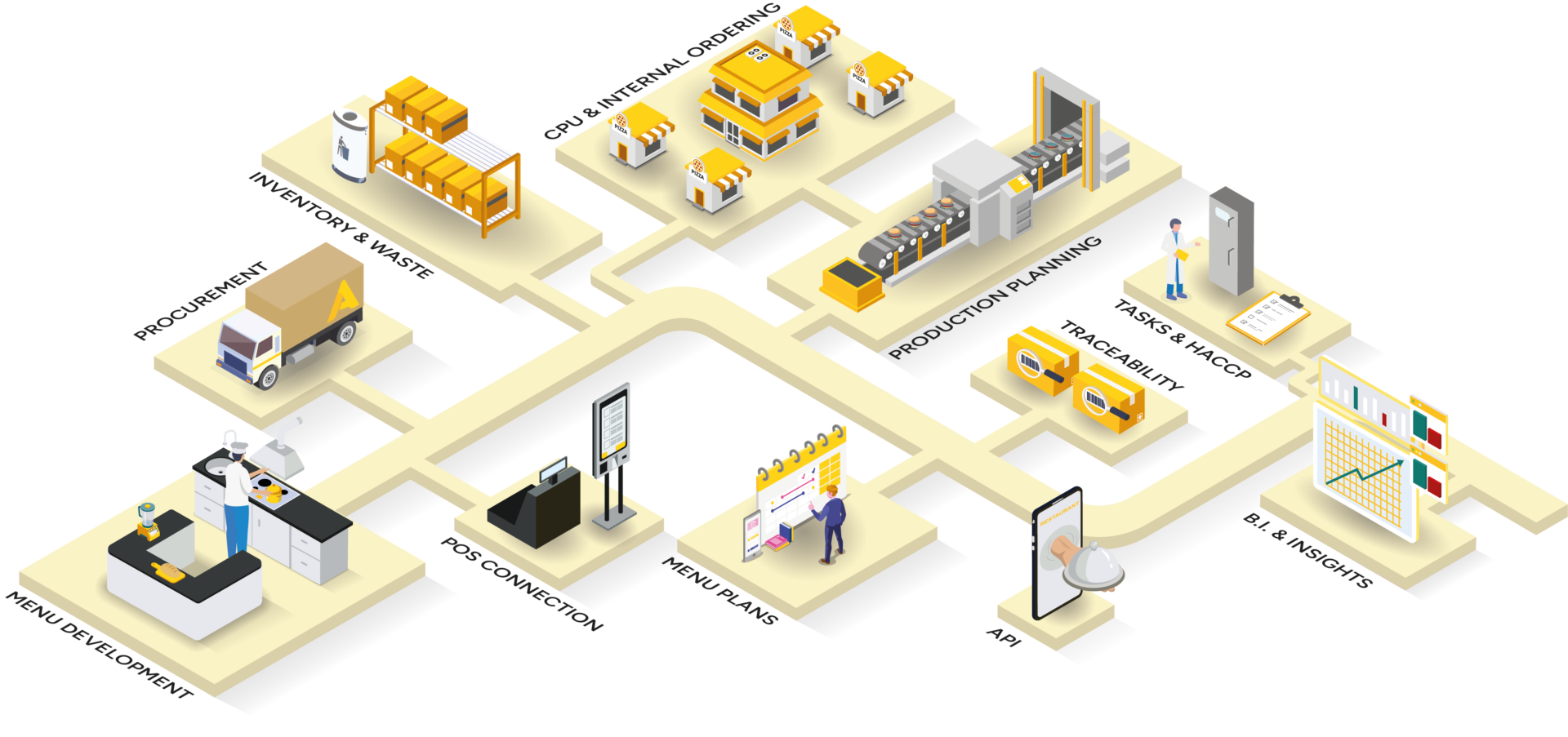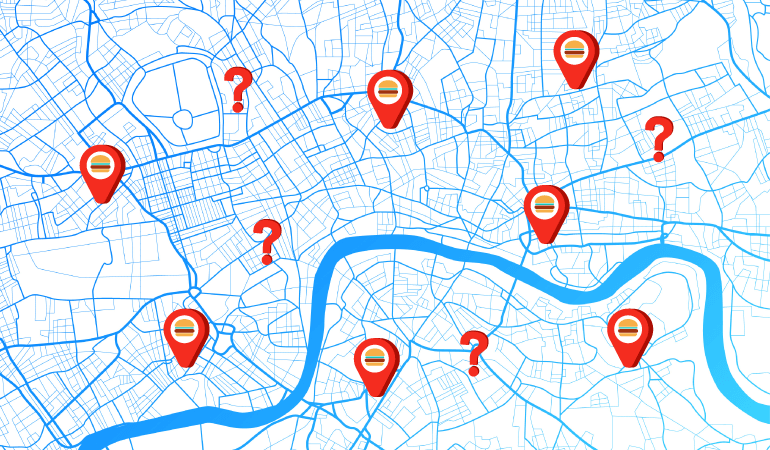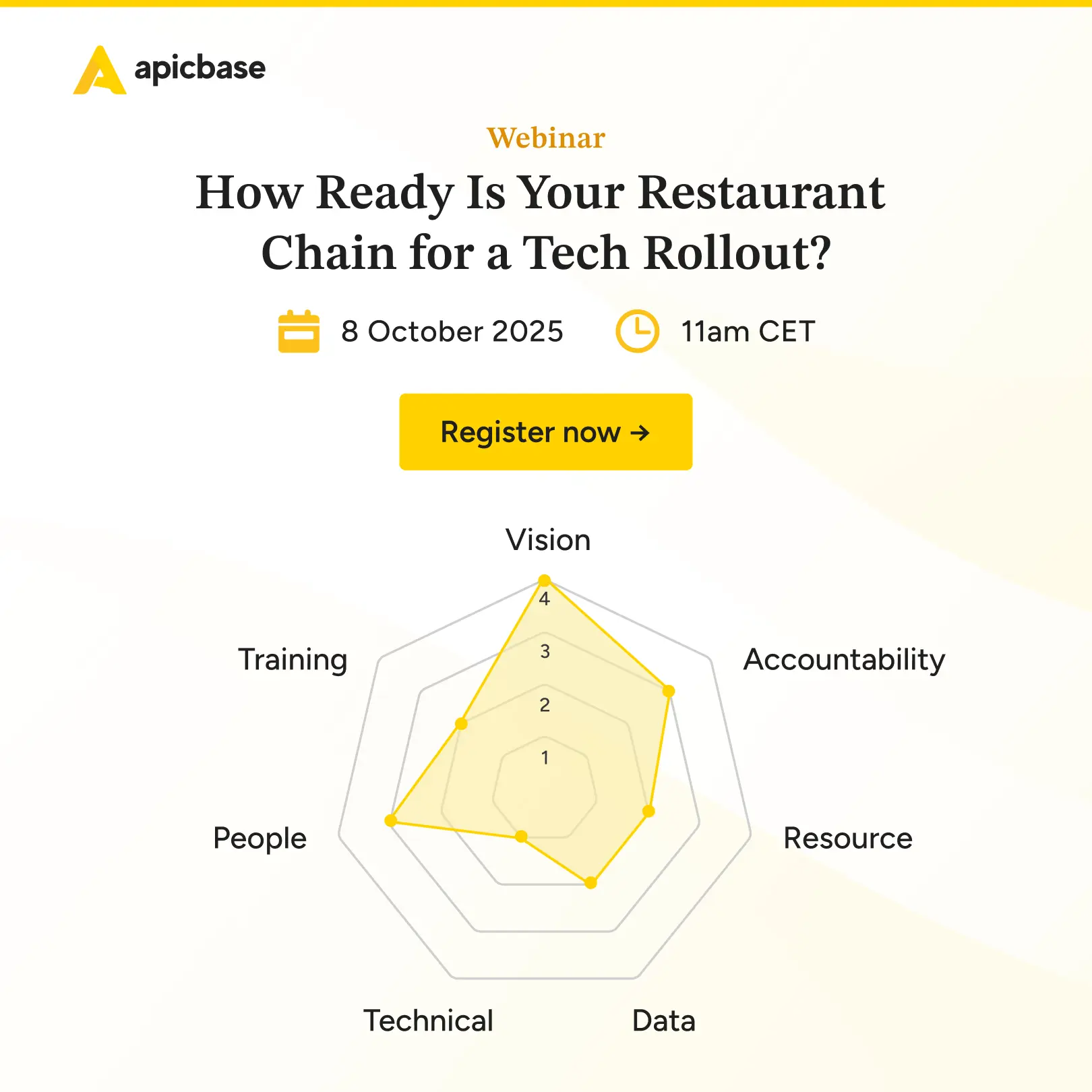You are running a couple of successful locations, and you’re working on a strategy to expand your restaurant business further. That is great. Working at scale has many advantages, ranging from more effective cost management to better employee retention.
That said, managing 30, 90 or 170 locations is very different from running two restaurants. In fact, the two are hardly comparable. With two locations, you’re always there. On the ground. You’re keeping an eye on everything from processes to people, and you’re close at hand when a problem needs fixing. When you run dozens of sites, you can’t do that anymore. You can’t be everywhere at once, so you have to find other ways to keep things running smoothly and make sure guests are happy.
To expand your restaurant you need a strategy, that is certain, but it doesn’t stop there. You also need repeatable and fail-proof operational processes, and tech that can scale with you. This is important, because the bigger your company becomes, the more people you’ll hire and the more data your restaurants will generate.
In this article, we answer the question of how to grow your restaurant business and provide insights into the core elements of a restaurant expansion strategy, starting with:
- The foundation
- The strategy for growth (corporate or franchise)
- The tech stack
Expanding Your Restaurant? Set Up a Robust Foundation First

Small problems become big ones when you multiply them by dozens of locations. For example, If your food cost percentage in your first restaurant is 23% in theory but 27% in reality. That’s a food cost variance of 4%. When not addressed properly, you’re soon talking about hundreds of thousands of euros lost per year.
Let’s do a quick calculation for a fast-casual restaurant with 37 branches. If the turnover at the first location is €1,000,000, the theoretical food costs are €230,000 and the actual €270,000. That is a difference of 40,000 euros. Scaled up to 37 units, the loss in gross profit is €1,480,000.
That’s a lot of money lost due to inefficiencies in the system. It’s best to iron those kinks out while you’re still only running one or two units because once you hit four or more restaurant locations, it’s going to be much more difficult to determin where things go wrong and it will take a lot more time and effort to recitify processes accross all those locations and train many more people on the new way of doing things.
We focus on creating consistency across all outlets. To get there, we have optimised our processes, upgraded systems, conducted audits and provided training. We can’t wait to open more locations in cool cities all over Europe!
Julien Zaal
CEO & Co-founder, The Avocado Show
Here’s a small list of things that you need to have in order before you start opening new restaurant locations:
- Know your concept — figure out what makes your business distinctive — what makes it tick — and lean into those advantages when scaling. Is it a signature dish? Make sure you bring it to every new location. Is it your lightning-fast delivery? Open only those locations that allow you to replicate that. Is it your super-friendly and witty front of house crew? Make staffing and training a priority.
- Work on your finances — when you think you can support growth with your balance sheet capital — give it a bit more time. You want to in the green before scaling your business because if anything’s true, it’s that restaurant expansion ends up costing double the amount you originally budget for it. And takes double the time sometimes, too. If you’re bankrolling it personally (or with a loan), make sure you can stay afloat if things don’t immediatly go as planned.
- Hone your processes — I mean, really hone ‘em. Everything from managing your inventory and waste to staff training and product development needs to be inspected, standardised, perfected (and then some), polished, and written down. The goal of it all is to get a blueprint that allows you to a) keep your food costs low, and b) find profit leaks and plug them. Once you have that blueprint, you can deploy it at every new location. Then, it’s just a matter of fine-tuning processes to specific needs.
- Get an A-list team — it takes a village to grow a restaurant business. Even if you end up selling franchises (about which more below), you still need to spend a large amount of time setting them up. This goes faster (and requires less of your time) if you have an experienced team on board. It also means building a business that people want to work for. So ask yourself: do we have a plan to attract, train and retain the best possible restaurant team. Keep in mind that no matter how much fun it is to work in your restaurants, people ultimately want meaningful work that puts food on the table and allows them to grow.
- Aim for consistency — scratch that… don’t aim for it — get it nailed down 100%. Flavours, experiences, service need to be in sync across your operation before adding more locations, suppliers and moving parts.
Restaurant Expansion Relies On Thorough Testing

Location, location, location.
This phrase from real estate sector also applies to the restaurant industry. Every business owner I spoke to immediately said ‘location’ when I asked about the basis of their success. Rent costs is your biggest fixed expense. It can easily be anywhere between 6 and 10% of your sales. These percentages vary wildly depending on the location, the condition of the space and so on. Keep in mind that rent cost benchmark ideally includes insurance, taxes and other location related costs.
A restaurant in a good location may have higher rent but more customers, so it can afford it. A restaurant in a bad location may aim for the lower end of this range to stay profitable. Restaurant owners need to think carefully about these benchmarks when planning their budgets and negotiating lease terms. It’ll help you make sure your business remains sustainable and profitable as you grow.
Make sure you are ready for restaurant expansion behind the scenes. Think in advance about how your guests came into contact with you at your first location.
Roy Goorts
Manager Formulas and Marketing – Brother Horeca Group
When choosing a new restaurant location, here are five things to keep in mind:
Everything from managing your inventory to staff training and purchasing protocols needs to be inspected, standardised, perfected, and documented.
- Your concept fits the location — don’t open a burger joint on a high street where your rent is € 10,000 per month. With a 10-euro average check amount, you need to sell 1,000 burgers just to cover your rent. And then 2,000 more to break even.
- You’re ready to go the first minute — these days, you don’t have the luxury of a slow month where you settle in, train your new crew, and iron stuff out. The minute you open, things need to be up to scratch — interiors, design, equipment, staff, training, tech stack. If you did your marketing right, your customers will come. And if your new location is not rearing to go, your Yelp rating will reflect that.
- There are restaurants there already — and, yes — you want them to be there. If they’re not, that means says something about the commrercial value of the area. This is a red flag — you should open here only if you’re 100% sure that plenty of your target audience lives, works or visits this place. Don’t be afraid of some light competition — if your concept is unique enough, it will carry you through.
- Supply chain is not (too) complicated — sometimes, a location can look great, but the logistics just don’t work. You need to think about sourcing and delivery – if you can’t get the stock you need consistently, your restaurant managers will inevitably start piling up small missteps that are detrimental to the unit’s profitability and ultimately to your overall brand reputation.
- You’ve done a low-cost test of your menu— When your brand is still pretty new, it can be a great idea to test your offer before committing to a lease. Why not go to the country/city/neighbourhood where you want to open a new location and rent out a cloud kitchen (or set up a small pop-up location)? Then, put your meals up on a third-party delivery channel. Just give yourself some time to test the waters and you’ll be fine! After about a month, you should have a pretty good idea of whether your items will be a hit or miss at that location.
Growth Strategy: Corporate or Franchise Expansion

You don’t need to own every single aspect of your growing restaurant business. There are plenty of ways to expand your restaurant operation without investing your own money or taking out a lown from the bank.
You can grow your restaurant business and launch your winning concept into the world (particularly internationally) through franchising. The benefit of expansion through franchise restaurants is you won’t have a new ongoing commitment with every location.
However, don’t make the mistake of thinking that selling a franchise is easy. Or that it doesn’t require any work on your part besides signing a contract (I highly recommend reading up on the Pitfalls Of Starting A Restaurant Franchise).
The franchisee pays you to use your brand and business model. But, you the real money comes from a share in the profits from the franchisee every month (anywhere between 4 and 12 per cent).
That’s why you want every new franchise location to be a hit. Here’s how:
- Choose your franchise partners wisely — fresh-off-the boat entrepreneurs, people looking for a career change, and retirees are not good franchise partners. They often lack drive, experience, and passion for foodservice, all of which are required to make this work. Choose people who have experience working in the restaurant industry, or, at very least, experience running a business. Also, focus on franchisees who want to operate multiple restaurant locations — they’ll become more independent with every new opening.
- Write down your SOPs, processes, and everything in between — give the franchisee all the tools they need to be successful. This means writing down and codifying everything that works in your current locations, from back-of-house operating procedures to your allergen management strategy. This is extra upfront work for you, but it makes success more likely for your franchisees.
- Invest time & money in guidance and training — your franchisee will need support, especially in the beginning. Be there for things like location selection, choosing real estate partners, and staffing. Explain what makes your concept work, and train them on how to replicate your results for themselves.
And one last thing — don’t rush into franchising.
Franchising is a great option for many, but it is important to understand that it is a very different business model to running restaurants yourself.
Your goal is to open successful and profitable locations. Since you will invest a lot of time in the early stages of every franchise, you don’t want to spread yourself too thin. Don’t grow faster than you can recruit competent people and find solid franchise partners.

Calculate & Control the Ideal Food Cost
Discover how to calculate and control the ideal & actual food cost to develop profitable menus.
Choose a Tech Stack That Can Scale with Your Restaurant Operations

Everything I talk about in this article – robust processes, centralised management, performance analytics – are easier to achieve with technology. How much easier depends on your tech ecosystem.
If you want your software solutions to facilitate and speed up your restaurant scaling, your tech ecosystem has to be:
- Cloud-based — having up-to-date data is crucial to running a successful operation. But, when you’re growing your restaurant business, it’s even more crucial that you have immediate access to every bit of data from everywhere. And that it’s comparable. And that every stakeholder (from your dev chef to your F&B manager) has access to it.
- Platform-based — a good restaurant management platform has all the rudimentary tools that you need to run an insights-informed business (from kitchen management to personnel management). But, one of its biggest advantages is that it can be built on. If you need a more robust staffing and training software, you can integrate it so that it communicates with your central platform. This helps you standardise everything so that you get valuable information that’s applicable across your operations.
- Scales with you — while it’s true that robust, all-in-one restaurant management solutions don’t come cheap, what’s even more expensive is completely overhauling your entire BoH management system. Especially in the middle of a big scaling push. This is where modular solutions come in. For two reasons:
One, you can connect new units as you grow, without having to copy recipes, menus, ingredients, allergens, etc. All that, is ready to go.
Two, with two, three locations you’ll probably only use the essentials because you’re still building out your business (modules such as product management, inventory, and analytics), and expand on them when it makes operational sense.
For example, when you add a central production kitchen to operations or start working with different supplier per area or when complexity increases for any other reason due to scale (demand forecasting, HACCP tasks, traceability).
Apicbase Ticks All Boxes
Apicbase is the most complete F&B Management Platform for multi-unit restaurants, hotels, ghost kitchens and large scale catering, giving you:
- A single source of truth for all things back of house
- No more data silos—no matter if you run 3 or 30 locations
- No more time-consuming spreadsheets
- A heavily reduced food cost & waste
- Controle over your menus, inventories and supply chain.
Scale Your Operations Faster With the Right Tech
Apicbase keeps your costs under control, streamlines operations & is ready to scale.



